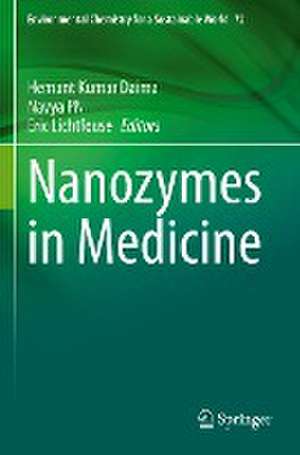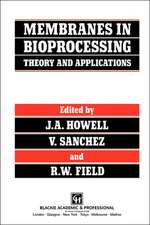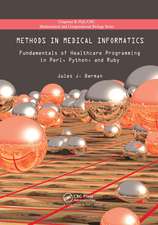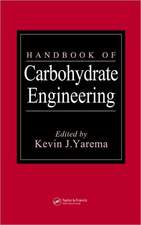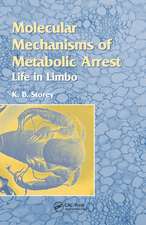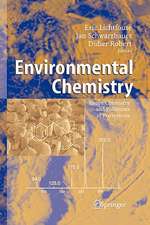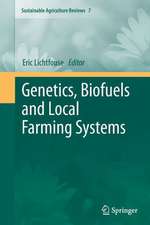Nanozymes in Medicine: Environmental Chemistry for a Sustainable World, cartea 72
Editat de Hemant Kumar Daima, Navya PN, Eric Lichtfouseen Limba Engleză Paperback – 5 ian 2024
| Toate formatele și edițiile | Preț | Express |
|---|---|---|
| Paperback (1) | 1104.74 lei 6-8 săpt. | |
| Springer Nature Switzerland – 5 ian 2024 | 1104.74 lei 6-8 săpt. | |
| Hardback (1) | 1110.72 lei 6-8 săpt. | |
| Springer Nature Switzerland – 4 ian 2023 | 1110.72 lei 6-8 săpt. |
Din seria Environmental Chemistry for a Sustainable World
- 18%
 Preț: 1118.45 lei
Preț: 1118.45 lei - 15%
 Preț: 645.79 lei
Preț: 645.79 lei - 15%
 Preț: 653.14 lei
Preț: 653.14 lei - 15%
 Preț: 648.24 lei
Preț: 648.24 lei - 15%
 Preț: 643.34 lei
Preț: 643.34 lei - 15%
 Preț: 651.51 lei
Preț: 651.51 lei - 15%
 Preț: 646.62 lei
Preț: 646.62 lei - 18%
 Preț: 956.81 lei
Preț: 956.81 lei - 18%
 Preț: 959.98 lei
Preț: 959.98 lei - 15%
 Preț: 646.62 lei
Preț: 646.62 lei - 18%
 Preț: 1389.30 lei
Preț: 1389.30 lei - 18%
 Preț: 1229.10 lei
Preț: 1229.10 lei - 18%
 Preț: 1001.81 lei
Preț: 1001.81 lei - 18%
 Preț: 1118.62 lei
Preț: 1118.62 lei - 18%
 Preț: 899.21 lei
Preț: 899.21 lei - 18%
 Preț: 1120.18 lei
Preț: 1120.18 lei - 18%
 Preț: 896.08 lei
Preț: 896.08 lei - 18%
 Preț: 788.72 lei
Preț: 788.72 lei - 18%
 Preț: 1009.70 lei
Preț: 1009.70 lei - 15%
 Preț: 650.86 lei
Preț: 650.86 lei - 15%
 Preț: 646.62 lei
Preț: 646.62 lei - 18%
 Preț: 1017.62 lei
Preț: 1017.62 lei - 18%
 Preț: 1118.62 lei
Preț: 1118.62 lei - 15%
 Preț: 644.95 lei
Preț: 644.95 lei - 5%
 Preț: 915.58 lei
Preț: 915.58 lei - 24%
 Preț: 751.40 lei
Preț: 751.40 lei - 18%
 Preț: 1008.12 lei
Preț: 1008.12 lei - 18%
 Preț: 1113.89 lei
Preț: 1113.89 lei - 18%
 Preț: 950.52 lei
Preț: 950.52 lei - 18%
 Preț: 959.98 lei
Preț: 959.98 lei - 15%
 Preț: 648.42 lei
Preț: 648.42 lei - 18%
 Preț: 950.96 lei
Preț: 950.96 lei - 23%
 Preț: 852.88 lei
Preț: 852.88 lei - 18%
 Preț: 959.50 lei
Preț: 959.50 lei - 20%
 Preț: 647.13 lei
Preț: 647.13 lei - 24%
 Preț: 744.58 lei
Preț: 744.58 lei - 18%
 Preț: 1215.22 lei
Preț: 1215.22 lei - 20%
 Preț: 570.17 lei
Preț: 570.17 lei - 24%
 Preț: 824.15 lei
Preț: 824.15 lei - 15%
 Preț: 647.59 lei
Preț: 647.59 lei
Preț: 1104.74 lei
Preț vechi: 1347.24 lei
-18% Nou
Puncte Express: 1657
Preț estimativ în valută:
211.38€ • 220.73$ • 174.56£
211.38€ • 220.73$ • 174.56£
Carte tipărită la comandă
Livrare economică 15-29 aprilie
Preluare comenzi: 021 569.72.76
Specificații
ISBN-13: 9783031205835
ISBN-10: 3031205839
Ilustrații: XV, 212 p. 1 illus.
Dimensiuni: 155 x 235 mm
Greutate: 0.33 kg
Ediția:1st ed. 2023
Editura: Springer Nature Switzerland
Colecția Springer
Seria Environmental Chemistry for a Sustainable World
Locul publicării:Cham, Switzerland
ISBN-10: 3031205839
Ilustrații: XV, 212 p. 1 illus.
Dimensiuni: 155 x 235 mm
Greutate: 0.33 kg
Ediția:1st ed. 2023
Editura: Springer Nature Switzerland
Colecția Springer
Seria Environmental Chemistry for a Sustainable World
Locul publicării:Cham, Switzerland
Cuprins
Chapter 1 Nano cerium oxide in medicine, agriculture and the industry.- Chapter 2 Synthesis and sensing applications of peroxidase-mimic nanozyme.- Chapter 3 Nanozymes for glucose sensing and diabetes management.- Chapter 4 Nanozymes for bioimaging and disease diagnostics.- Chapter 5 Nanozymes for improving anticancer therapy.- Chapter 6 Enzyme-based nanomedicine for cancer therapy.- Chapter 7. Synthesis of two-dimensional metal, metal oxide and metal hydroxide nanomaterials for biosensing.- Chapter 8 Biological applications of nanozymes.
Notă biografică
Dr. Hemant Kumar Daima is a nanobiotechnology expert at Amity University Rajasthan, India and visiting scientist at RMIT University, Australia. His research findings have revealed principles for rational design of nanozymes for biomedical applications. He is an editorial board member of leading scientific journals, member of numerous scientific and professional bodies, and recipient of international fellowships and awards.
Navya PN is working at RMIT University, Australia, and earlier she has worked as Assistant Professor at the Bannari Amman Institute of Technology, India and Assistant Professor at the Siddaganga Institute of Technology, India. She is cofounder of Nano-Bio Interfacial Research Laboratory. She does research at the interface between nanotechnology and biology. She is a recipient of several international fellowships.
Dr. Eric Lichtfouse is Professor of environmental science and scientific writing at Aix Marseille University, France, Xi'an Jioatong University and the University of Shanghai for Science and Technology, China. He has invented carbon-13 dating and published the book Scientific Writing for Impact Factor Journals. He has awards in analytical chemistry and scientific editing, and is XTerra world vice-champion in his age category.
Navya PN is working at RMIT University, Australia, and earlier she has worked as Assistant Professor at the Bannari Amman Institute of Technology, India and Assistant Professor at the Siddaganga Institute of Technology, India. She is cofounder of Nano-Bio Interfacial Research Laboratory. She does research at the interface between nanotechnology and biology. She is a recipient of several international fellowships.
Dr. Eric Lichtfouse is Professor of environmental science and scientific writing at Aix Marseille University, France, Xi'an Jioatong University and the University of Shanghai for Science and Technology, China. He has invented carbon-13 dating and published the book Scientific Writing for Impact Factor Journals. He has awards in analytical chemistry and scientific editing, and is XTerra world vice-champion in his age category.
Textul de pe ultima copertă
This book reviews the latest advances and biomedical applications of nanozymes, which are artificial nanomaterials exhibiting enzymatic properties similar to natural enzymes, but with less limitations than natural enzymes. Nanozymes display advantages such as facile synthesis, easy surface modification, improved stability, higher catalytic power, and target-specific binding. Nanozymes containing metals, metal oxides, carbon, and metal sulfide are actually used for cancer therapy, biomolecules sensing, bioimaging, disease diagnostics and diabetes management. The book discloses underlying mechanisms, concepts, recent trends, constraints, and prospects for nanomedicine using nanozymes.
Caracteristici
Presents different types of nanozymes that have been developed and functionalized for biomedical applications Describes the reaction mechanism and future directions for nanozymes based sensing, diagnostics, disease management State-of-the-art contemporary contributions from the global leaders
